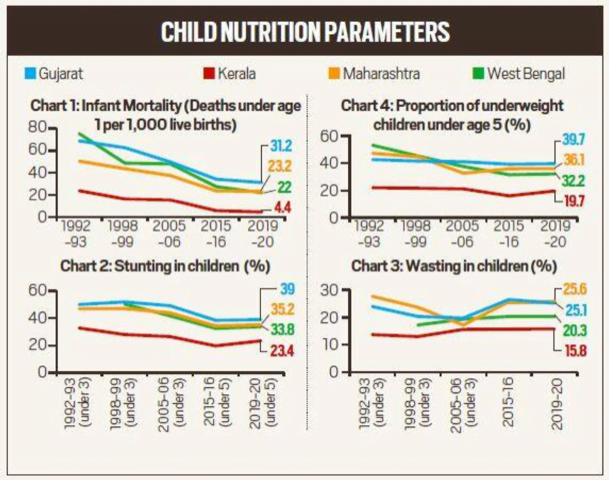UPSC Articles
SOCIETY/ HEALTH/ GOVERNANCE
Topic: General Studies 1,2:
- Social Empowerment
- Issues relating to development and management of Social Sector/Services relating to Health and Human Resources.
- Government policies and interventions for development in various sectors and issues arising out of their design and implementation.
Reading NFHS data
Context: The Ministry of Health and Family Welfare (MoHFW) recently released the results from the first phase of the National Family Health Survey (NHFS).
What is National Health Family Survey (NHFS)?
- NFHS is a large-scale nationwide survey of representative households. The data is collected over multiple rounds.
- Implementation Agencies: The MoHFW has designated International Institute for Population Sciences in Mumbai as the nodal agency and the survey is a collaborative effort of IIPS; ORC Macro, Maryland (US); and the East-West Center, Hawaii (US).
- Funding: The survey is funded by the United States Agency for International Development (USAID) with supplementary support from UNICEF.
- Previous Surveys: The first four NHFS were conducted in 1992-93, 1998-99, 2005-06 and 2015-16, respectively.
What data does it collect?
- The initial factsheet for NFHS-5 provides state-wise data on 131 parameters.
- These parameters include questions such as how many households get drinking water, electricity and improved sanitation; what is sex ratio at birth, what are infant and child mortality metrics, what is the status of maternal and child health, how many have high blood sugar or high blood pressure etc.
- Each round of NFHS has also expanded the scope of inquiry.
- In the fifth iteration, for instance, there are new questions on preschool education, disability, access to a toilet facility, death registration, bathing practices during menstruation, and methods and reasons for abortion.
Why are NFHS results important?
- Evidence Based Policy making: The NFHS database is possibly the most important one because it not only feeds into the research needs and informs advocacy but also is central to both central and state-level policymaking.
- International Comparison: NFHS survey results also provide internationally comparable results. That’s because the questions and the methodology is internationally valid. Thus, it places the results of say child malnutrition trends in Bihar in the global context.
About NHFS-5
- The first phase of NHFS — for which data was collected in the second half of 2019 — covered 17 states and five Union Territories.
- The second phase of the survey was disrupted by the Covid-19 pandemic; its results are expected to come out in May 2021. The second phase will cover some of the biggest states such as Uttar Pradesh, Madhya Pradesh, Punjab and Jharkhand.
- The most important takeaway of study of first phase is that between 2015 and 2019, several Indian states have suffered a reversal on several child malnutrition parameters

What has NFHS-5 found?
- Worsening Child Malnutrition: The most troubling finding is that on child malnutrition parameters — such as infant and child (under 5 years of age) mortality, child stunting (low height for one’s age), child wasting ( low weight for one’s height) and proportion of underweight children — several states have either been stagnant or worsened (refer above figure)
- In other words, children born between 2014 and 2019 (that is, 0 to 5 years of age) are more malnourished than the previous generation.
- Indicates Chronic Malnutrition: The reversal in the proportion of children who are stunted is the most worrisome because unlike wasting and being underweight (which can be due to short term reasons and represent acute malnutrition), stunting represents chronic malnutrition. Reversals in stunting are unheard of in growing economies with stable democracies.
- Second Phase may throw worse results due to impact ofPandemic: Another cause of concern is the fact that the first phase data is pre-pandemic and it is quite likely that the second phase — which will also incorporate Covid’s impact — may throw up ever poorer results.
What is the significance of these results?
- Malnutrition leads to poor human resources: Worsening child malnutrition, as well as rising levels of anaemia in women (especially pregnant ones), points to Indian children born in the past 5 years likely suffering from both cognitive and physical deficiencies.
- Initiatives on Sanitation not yielded results: Between NFHS-3 (2005-06) and NFHS-4 (2015-16), India registered its most significant reduction in child malnutrition, thanks to a flurry of interventions such nutrition missions, ICDS, MGNREGA and expansion of PDS among others. The latest results show that health-wise, India has taken a turn for the worse since 2015 despite improvements in water availability and sanitation methods.
- Needs further analysis: Experts say that only when the full set of raw unit-level data is available can a proper analysis of why India suffered such reversals over the past five years be done.
Conclusion
Health outcomes such as child malnutrition data are the result of a complex set of reasons — ranging from the state of a family’s income generation to environmental factors to government interventions.













